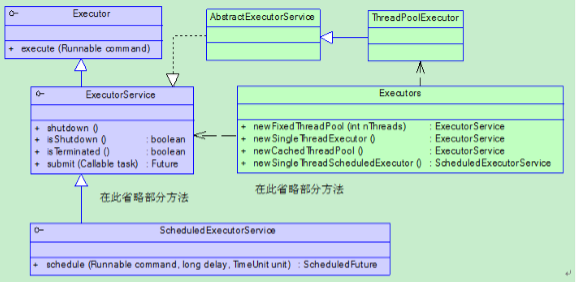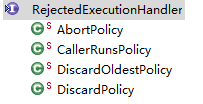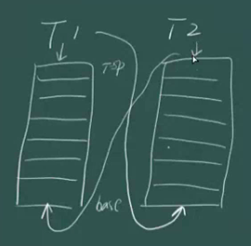1. 線程池的基本使用
1.1.為什么需要線程池
平時(shí)的業(yè)務(wù)中,如果要使用多線程,那么我們會在業(yè)務(wù)開始前創(chuàng)建線程,業(yè)務(wù)結(jié)束后,銷毀線程。但是對于業(yè)務(wù)來說,線程的創(chuàng)建和銷毀是與業(yè)務(wù)本身無關(guān)的,只關(guān)心線程所執(zhí)行的任務(wù)。因此希望把盡可能多的cpu用在執(zhí)行任務(wù)上面,而不是用在與業(yè)務(wù)無關(guān)的線程創(chuàng)建和銷毀上面。而線程池則解決了這個(gè)問題,線程池的作用就是將線程進(jìn)行復(fù)用。
1.2.JDK為我們提供了哪些支持

JDK中的相關(guān)類圖如上圖所示。
其中要提到的幾個(gè)特別的類。
Callable類和Runable類相似,但是區(qū)別在于Callable有返回值。
ThreadPoolExecutor是線程池的一個(gè)重要實(shí)現(xiàn)。
而Executors是一個(gè)工廠類。
1.3.線程池的使用
1.3.1.線程池的種類
- new FixedThreadPool 固定數(shù)量的線程池,線程池中的線程數(shù)量是固定的,不會改變。
- new SingleThreadExecutor 單一線程池,線程池中只有一個(gè)線程。
- new CachedThreadPool 緩存線程池,線程池中的線程數(shù)量不固定,會根據(jù)需求的大小進(jìn)行改變。
- new ScheduledThreadPool 計(jì)劃任務(wù)調(diào)度的線程池,用于執(zhí)行計(jì)劃任務(wù),比如每隔5分鐘怎么樣,
|
1
2
3
4
5
6
7
8
9
10
11
12
13
14
15
16
17
18
19
20
|
public static ExecutorService newFixedThreadPool(int nThreads) { return new ThreadPoolExecutor(nThreads, nThreads, 0L, TimeUnit.MILLISECONDS, new LinkedBlockingQueue<Runnable>());}public static ExecutorService newSingleThreadExecutor() { return new FinalizableDelegatedExecutorService (new ThreadPoolExecutor(1, 1, 0L, TimeUnit.MILLISECONDS, new LinkedBlockingQueue<Runnable>()));}public static ExecutorService newCachedThreadPool() { return new ThreadPoolExecutor(0, Integer.MAX_VALUE, 60L, TimeUnit.SECONDS, new SynchronousQueue<Runnable>());} |
從方法上來看,顯然 FixedThreadPool,SingleThreadExecutor,CachedThreadPool都是ThreadPoolExecutor的不同實(shí)例,只是參數(shù)不同。
|
1
2
3
4
5
6
7
8
|
public ThreadPoolExecutor(int corePoolSize, int maximumPoolSize, long keepAliveTime, TimeUnit unit, BlockingQueue<Runnable> workQueue) { this(corePoolSize, maximumPoolSize, keepAliveTime, unit, workQueue, Executors.defaultThreadFactory(), defaultHandler);} |
下面來簡述下 ThreadPoolExecutor構(gòu)造函數(shù)中參數(shù)的含義。
- corePoolSize 線程池中核心線程數(shù)的數(shù)目
- maximumPoolSize 線程池中最多能容納多少個(gè)線程
- keepAliveTime 當(dāng)現(xiàn)在線程數(shù)目大于corePoolSize時(shí),超過keepAliveTime時(shí)間后,多出corePoolSize的那些線程將被終結(jié)。
- unit keepAliveTime的單位
- workQueue 當(dāng)任務(wù)數(shù)量很大,線程池中線程無法滿足時(shí),提交的任務(wù)會被放到阻塞隊(duì)列中,線程空閑下來則會不斷從阻塞隊(duì)列中取數(shù)據(jù)。
這樣在來看上面所說的FixedThreadPool,它的線程的核心數(shù)目和最大容納數(shù)目都是一樣的,以至于在工作期間,并不會創(chuàng)建和銷毀線程。當(dāng)任務(wù)數(shù)量很大,線程池中的線程無法滿足時(shí),任務(wù)將被保存到LinkedBlockingQueue中,而LinkedBlockingQueue的大小是Integer.MAX_VALUE。這就意味著,任務(wù)不斷地添加,會使內(nèi)存消耗越來越大。
而CachedThreadPool則不同,它的核心線程數(shù)量是0,最大容納數(shù)目是Integer.MAX_VALUE,它的阻塞隊(duì)列是SynchronousQueue,這是一個(gè)特別的隊(duì)列,它的大小是0。由于核心線程數(shù)量是0,所以必然要將任務(wù)添加到SynchronousQueue中,這個(gè)隊(duì)列只有一個(gè)線程在從中添加數(shù)據(jù),同時(shí)另一個(gè)線程在從中獲取數(shù)據(jù)時(shí),才能成功。獨(dú)自往這個(gè)隊(duì)列中添加數(shù)據(jù)會返回失敗。當(dāng)返回失敗時(shí),則線程池開始擴(kuò)展線程,這就是為什么CachedThreadPool的線程數(shù)目是不固定的。當(dāng)60s該線程仍未被使用時(shí),線程則被銷毀。
1.4.線程池使用的小例子
1.4.1.簡單線程池
|
1
2
3
4
5
6
7
8
9
10
11
12
13
14
15
16
17
18
19
20
21
22
23
24
25
|
import java.util.concurrent.ExecutorService;import java.util.concurrent.Executors;public class ThreadPoolDemo { public static class MyTask implements Runnable { @Override public void run() { System.out.println(System.currentTimeMillis() + "Thread ID:" + Thread.currentThread().getId()); try { Thread.sleep(1000); } catch (Exception e) { e.printStackTrace(); } } } public static void main(String[] args) { MyTask myTask = new MyTask(); ExecutorService es = Executors.newFixedThreadPool(5); for (int i = 0; i < 10; i++) { es.submit(myTask); } }} |
由于使用的newFixedThreadPool(5),但是啟動了10個(gè)線程,所以每次執(zhí)行5個(gè),并且 可以很明顯的看到線程的復(fù)用,ThreadId是重復(fù)的,也就是前5個(gè)任務(wù)和后5個(gè)任務(wù)都是同一批線程去執(zhí)行的。
這里用的是
es.submit(myTask);
還有一種提交方式:
es.execute(myTask);
區(qū)別在于submit會返回一個(gè)Future對象,這個(gè)將在以后介紹。
1.4.2.ScheduledThreadPool
|
1
2
3
4
5
6
7
8
9
10
11
12
13
14
15
16
17
18
19
20
21
22
23
24
|
import java.util.concurrent.Executors;import java.util.concurrent.ScheduledExecutorService;import java.util.concurrent.TimeUnit;public class ThreadPoolDemo { public static void main(String[] args) { ScheduledExecutorService ses = Executors.newScheduledThreadPool(10); //如果前面的任務(wù)還未完成,則調(diào)度不會啟動。 ses.scheduleWithFixedDelay(new Runnable() { @Override public void run() { try { Thread.sleep(1000); System.out.println(System.currentTimeMillis()/1000); } catch (Exception e) { // TODO: handle exception } } }, 0, 2, TimeUnit.SECONDS);//啟動0秒后執(zhí)行,然后周期2秒執(zhí)行一次 }} |
輸出:
1454832514
1454832517
1454832520
1454832523
1454832526
...
由于任務(wù)執(zhí)行需要1秒,任務(wù)調(diào)度必須等待前一個(gè)任務(wù)完成。也就是這里的每隔2秒的意思是,前一個(gè)任務(wù)完成后2秒再開啟新的一個(gè)任務(wù)。
2. 擴(kuò)展和增強(qiáng)線程池
2.1.回調(diào)接口
線程池中有一些回調(diào)的api來給我們提供擴(kuò)展的操作。
|
1
2
3
4
5
6
7
8
9
10
11
12
13
14
15
16
17
18
19
|
ExecutorService es = new ThreadPoolExecutor(5, 5, 0L, TimeUnit.SECONDS, new LinkedBlockingQueue<Runnable>()){ @Override protected void beforeExecute(Thread t, Runnable r) { System.out.println("準(zhǔn)備執(zhí)行"); } @Override protected void afterExecute(Runnable r, Throwable t) { System.out.println("執(zhí)行完成"); } @Override protected void terminated() { System.out.println("線程池退出"); } }; |
我們可以通過實(shí)現(xiàn)ThreadPoolExecutor的子類去覆蓋ThreadPoolExecutor的beforeExecute,afterExecute,terminated方法來實(shí)現(xiàn)在線程執(zhí)行前后,線程池退出時(shí)的日志管理或其他操作。
2.2.拒絕策略
有時(shí)候,任務(wù)非常繁重,導(dǎo)致系統(tǒng)負(fù)載太大。在上面說過,當(dāng)任務(wù)量越來越大時(shí),任務(wù)都將放到FixedThreadPool的阻塞隊(duì)列中,導(dǎo)致內(nèi)存消耗太大,最終導(dǎo)致內(nèi)存溢出。這樣的情況是應(yīng)該要避免的。因此當(dāng)我們發(fā)現(xiàn)線程數(shù)量要超過最大線程數(shù)量時(shí),我們應(yīng)該放棄一些任務(wù)。丟棄時(shí),我們應(yīng)該把任務(wù)記下來,而不是直接丟掉。
ThreadPoolExecutor中還有另一個(gè)構(gòu)造函數(shù)。
|
1
2
3
4
5
6
7
8
9
10
11
12
13
14
15
16
17
18
19
20
21
|
public ThreadPoolExecutor(int corePoolSize, int maximumPoolSize, long keepAliveTime, TimeUnit unit, BlockingQueue<Runnable> workQueue, ThreadFactory threadFactory, RejectedExecutionHandler handler) { if (corePoolSize < 0 || maximumPoolSize <= 0 || maximumPoolSize < corePoolSize || keepAliveTime < 0) throw new IllegalArgumentException(); if (workQueue == null || threadFactory == null || handler == null) throw new NullPointerException(); this.corePoolSize = corePoolSize; this.maximumPoolSize = maximumPoolSize; this.workQueue = workQueue; this.keepAliveTime = unit.toNanos(keepAliveTime); this.threadFactory = threadFactory; this.handler = handler; } |
threadFactory我們在后面再介紹。
而handler就是拒絕策略的實(shí)現(xiàn),它會告訴我們,如果任務(wù)不能執(zhí)行了,該怎么做。

共有以上4種策略。
AbortPolicy:如果不能接受任務(wù)了,則拋出異常。
CallerRunsPolicy:如果不能接受任務(wù)了,則讓調(diào)用的線程去完成。
DiscardOldestPolicy:如果不能接受任務(wù)了,則丟棄最老的一個(gè)任務(wù),由一個(gè)隊(duì)列來維護(hù)。
DiscardPolicy:如果不能接受任務(wù)了,則丟棄任務(wù)。
|
1
2
3
4
5
6
7
8
9
10
|
ExecutorService es = new ThreadPoolExecutor(5, 5, 0L, TimeUnit.SECONDS, new LinkedBlockingQueue<Runnable>(), new RejectedExecutionHandler() { @Override public void rejectedExecution(Runnable r, ThreadPoolExecutor executor) { System.out.println(r.toString() + "is discard"); } }); |
當(dāng)然我們也可以自己實(shí)現(xiàn)RejectedExecutionHandler接口來自己定義拒絕策略。
2.3.自定義ThreadFactory
剛剛已經(jīng)看到了,在ThreadPoolExecutor的構(gòu)造函數(shù)中可以指定threadFactory。
線程池中的線程都是由線程工廠創(chuàng)建出來,我們可以自定義線程工廠。
默認(rèn)的線程工廠:
|
1
2
3
4
5
6
7
8
9
10
11
12
13
14
15
16
17
18
19
20
21
22
23
24
25
26
|
static class DefaultThreadFactory implements ThreadFactory { private static final AtomicInteger poolNumber = new AtomicInteger(1); private final ThreadGroup group; private final AtomicInteger threadNumber = new AtomicInteger(1); private final String namePrefix; DefaultThreadFactory() { SecurityManager s = System.getSecurityManager(); group = (s != null) ? s.getThreadGroup() : Thread.currentThread().getThreadGroup(); namePrefix = "pool-" + poolNumber.getAndIncrement() + "-thread-"; } public Thread newThread(Runnable r) { Thread t = new Thread(group, r, namePrefix + threadNumber.getAndIncrement(), 0); if (t.isDaemon()) t.setDaemon(false); if (t.getPriority() != Thread.NORM_PRIORITY) t.setPriority(Thread.NORM_PRIORITY); return t; } } |
3. ForkJoin
3.1.思想

就是分而治之的思想。
fork/join類似MapReduce算法,兩者區(qū)別是:Fork/Join 只有在必要時(shí)如任務(wù)非常大的情況下才分割成一個(gè)個(gè)小任務(wù),而 MapReduce總是在開始執(zhí)行第一步進(jìn)行分割。看來,F(xiàn)ork/Join更適合一個(gè)JVM內(nèi)線程級別,而MapReduce適合分布式系統(tǒng)。
4.2.使用接口
RecursiveAction:無返回值
RecursiveTask:有返回值
4.3.簡單例子
|
1
2
3
4
5
6
7
8
9
10
11
12
13
14
15
16
17
18
19
20
21
22
23
24
25
26
27
28
29
30
31
32
33
34
35
36
37
38
39
40
41
42
43
44
45
46
47
48
49
50
51
52
53
54
55
56
57
58
59
60
61
62
63
64
65
|
import java.util.ArrayList;import java.util.concurrent.ForkJoinPool;import java.util.concurrent.ForkJoinTask;import java.util.concurrent.RecursiveTask;public class CountTask extends RecursiveTask<Long>{ private static final int THRESHOLD = 10000; private long start; private long end; public CountTask(long start, long end) { super(); this.start = start; this.end = end; } @Override protected Long compute() { long sum = 0; boolean canCompute = (end - start) < THRESHOLD; if(canCompute) { for (long i = start; i <= end; i++) { sum = sum + i; } }else { //分成100個(gè)小任務(wù) long step = (start + end)/100; ArrayList<CountTask> subTasks = new ArrayList<CountTask>(); long pos = start; for (int i = 0; i < 100; i++) { long lastOne = pos + step; if(lastOne > end ) { lastOne = end; } CountTask subTask = new CountTask(pos, lastOne); pos += step + 1; subTasks.add(subTask); subTask.fork();//把子任務(wù)推向線程池 } for (CountTask t : subTasks) { sum += t.join();//等待所有子任務(wù)結(jié)束 } } return sum; } public static void main(String[] args) { ForkJoinPool forkJoinPool = new ForkJoinPool(); CountTask task = new CountTask(0, 200000L); ForkJoinTask<Long> result = forkJoinPool.submit(task); try { long res = result.get(); System.out.println("sum = " + res); } catch (Exception e) { // TODO: handle exception e.printStackTrace(); } }} |
上述例子描述了一個(gè)累加和的任務(wù)。將累加任務(wù)分成100個(gè)任務(wù),每個(gè)任務(wù)只執(zhí)行一段數(shù)字的累加和,最后join后,把每個(gè)任務(wù)計(jì)算出的和再累加起來。
4.4.實(shí)現(xiàn)要素
4.4.1.WorkQueue與ctl
每一個(gè)線程都會有一個(gè)工作隊(duì)列
static final class WorkQueue
在工作隊(duì)列中,會有一系列對線程進(jìn)行管理的字段
volatile int eventCount; // encoded inactivation count; < 0 if inactive
int nextWait; // encoded record of next event waiter
int nsteals; // number of steals
int hint; // steal index hint
short poolIndex; // index of this queue in pool
final short mode; // 0: lifo, > 0: fifo, < 0: shared
volatile int qlock; // 1: locked, -1: terminate; else 0
volatile int base; // index of next slot for poll
int top; // index of next slot for push
ForkJoinTask<?>[] array; // the elements (initially unallocated)
final ForkJoinPool pool; // the containing pool (may be null)
final ForkJoinWorkerThread owner; // owning thread or null if shared
volatile Thread parker; // == owner during call to park; else null
volatile ForkJoinTask<?> currentJoin; // task being joined in awaitJoin
ForkJoinTask<?> currentSteal; // current non-local task being executed
這里要注意的是,JDK7和JDK8在ForkJoin的實(shí)現(xiàn)上有了很大的差別。我們這里介紹的是JDK8中的。 在線程池中,有時(shí)不是所有的線程都在執(zhí)行的,部分線程會被掛起,那些掛起的線程會被存放到一個(gè)棧中。內(nèi)部通過一個(gè)鏈表表示。
nextWait會指向下一個(gè)等待的線程。
poolIndex線程在線程池中的下標(biāo)索引。
eventCount 在初始化時(shí),eventCount與poolIndex有關(guān)。總共32位,第一位表示是否被激活,15位表示被掛起的次數(shù)
eventCount,剩下的表示poolIndex。用一個(gè)字段來表示多個(gè)意思。
工作隊(duì)列WorkQueue用ForkJoinTask<?>[] array來表示。而top,base來表示隊(duì)列的兩端,數(shù)據(jù)在這兩者之間。
在ForkJoinPool中維護(hù)著ctl(64位long型)
volatile long ctl;
* Field ctl is a long packed with:
* AC: Number of active running workers minus target parallelism (16 bits)
* TC: Number of total workers minus target parallelism (16 bits)
* ST: true if pool is terminating (1 bit)
* EC: the wait count of top waiting thread (15 bits)
* ID: poolIndex of top of Treiber stack of waiters (16 bits)
AC表示活躍的線程數(shù)減去并行度(大概就是CPU個(gè)數(shù))
TC表示總的線程數(shù)減去并行度
ST表示線程池本身是否是激活的
EC表示頂端等待線程的掛起數(shù)
ID表示頂端等待線程的poolIndex
很明顯ST+EC+ID就是我們剛剛所說的 eventCount 。
那么為什么明明5個(gè)變量,非要合成一個(gè)變量呢。其實(shí)用5個(gè)變量占用容量也差不多。
用一個(gè)變量代碼的可讀性上會差很多。
那么為什么用一個(gè)變量呢?其實(shí)這點(diǎn)才是最巧妙的地方,因?yàn)檫@5個(gè)變量是一個(gè)整體,在多線程中,如果用5個(gè)變量,那么當(dāng)修改其中一個(gè)變量時(shí),如何保證5個(gè)變量的整體性。那么用一個(gè)變量則就解決了這個(gè)問題。如果用鎖解決,則會降低性能。
用一個(gè)變量則保證了數(shù)據(jù)的一致性和原子性。
在ForkJoin中隊(duì)ctl的更改都是使用CAS操作,在前面系列的文章中已經(jīng)介紹過,CAS是無鎖的操作,性能很好。
由于CAS操作也只能針對一個(gè)變量,所以這種設(shè)計(jì)是最優(yōu)的。
4.4.2.工作竊取
接下來要介紹下整個(gè)線程池的工作流程。
每個(gè)線程都會調(diào)用runWorker
|
1
2
3
4
5
6
|
final void runWorker(WorkQueue w) { w.growArray(); // allocate queue for (int r = w.hint; scan(w, r) == 0; ) { r ^= r << 13; r ^= r >>> 17; r ^= r << 5; // xorshift } } |
scan()函數(shù)是掃描是否有任務(wù)要做。
r是一個(gè)相對隨機(jī)的數(shù)字。
|
1
2
3
4
5
6
7
8
9
10
11
12
13
14
15
16
17
18
19
20
21
22
23
24
25
26
27
28
29
30
31
32
33
34
35
36
37
38
39
|
private final int scan(WorkQueue w, int r) { WorkQueue[] ws; int m; long c = ctl; // for consistency check if ((ws = workQueues) != null && (m = ws.length - 1) >= 0 && w != null) { for (int j = m + m + 1, ec = w.eventCount;;) { WorkQueue q; int b, e; ForkJoinTask<?>[] a; ForkJoinTask<?> t; if ((q = ws[(r - j) & m]) != null && (b = q.base) - q.top < 0 && (a = q.array) != null) { long i = (((a.length - 1) & b) << ASHIFT) + ABASE; if ((t = ((ForkJoinTask<?>) U.getObjectVolatile(a, i))) != null) { if (ec < 0) helpRelease(c, ws, w, q, b); else if (q.base == b && U.compareAndSwapObject(a, i, t, null)) { U.putOrderedInt(q, QBASE, b + 1); if ((b + 1) - q.top < 0) signalWork(ws, q); w.runTask(t); } } break; } else if (--j < 0) { if ((ec | (e = (int)c)) < 0) // inactive or terminating return awaitWork(w, c, ec); else if (ctl == c) { // try to inactivate and enqueue long nc = (long)ec | ((c - AC_UNIT) & (AC_MASK|TC_MASK)); w.nextWait = e; w.eventCount = ec | INT_SIGN; if (!U.compareAndSwapLong(this, CTL, c, nc)) w.eventCount = ec; // back out } break; } } } return 0; } |
我們接下來看看scan方法,scan的一個(gè)參數(shù)是WorkQueue,上面已經(jīng)說過,每個(gè)線程都會擁有一個(gè)WorkQueue,那么多個(gè)線程的WorkQueue就會保存在workQueues里面,r是一個(gè)隨機(jī)數(shù),通過r來找到某一個(gè) WorkQueue,在WorkQueue里面有所要做的任務(wù)。
然后通過WorkQueue的base,取得base的偏移量。
b = q.base
..
long i = (((a.length - 1) & b) << ASHIFT) + ABASE;
..
然后通過偏移量得到最后一個(gè)的任務(wù),運(yùn)行這個(gè)任務(wù)
t = ((ForkJoinTask<?>)U.getObjectVolatile(a, i))
..
w.runTask(t);
..
通過這個(gè)大概的分析理解了過程,我們發(fā)現(xiàn),當(dāng)前線程調(diào)用scan方法后,不會執(zhí)行當(dāng)前的WorkQueue中的任務(wù),而是通過一個(gè)隨機(jī)數(shù)r,來得到其他 WorkQueue的任務(wù)。這就是ForkJoinPool的主要的一個(gè)機(jī)理。
當(dāng)前線程不會只著眼于自己的任務(wù),而是優(yōu)先完成其他任務(wù)。這樣做來,防止了饑餓現(xiàn)象的發(fā)生。這樣就預(yù)防了某些線程因?yàn)榭ㄋ阑蛘咂渌蚨鵁o法及時(shí)完成任務(wù),或者某個(gè)線程的任務(wù)量很大,其他線程卻沒事可做。
然后來看看runTask方法
|
1
2
3
4
5
6
7
8
9
10
11
12
13
14
15
16
17
18
19
20
21
22
23
24
|
final void runTask(ForkJoinTask<?> task) { if ((currentSteal = task) != null) { ForkJoinWorkerThread thread; task.doExec(); ForkJoinTask<?>[] a = array; int md = mode; ++nsteals; currentSteal = null; if (md != 0) pollAndExecAll(); else if (a != null) { int s, m = a.length - 1; ForkJoinTask<?> t; while ((s = top - 1) - base >= 0 && (t = (ForkJoinTask<?>)U.getAndSetObject (a, ((m & s) << ASHIFT) + ABASE, null)) != null) { top = s; t.doExec(); } } if ((thread = owner) != null) // no need to do in finally clause thread.afterTopLevelExec(); } } |
有一個(gè)有趣的命名:currentSteal,偷得的任務(wù),的確是剛剛解釋的那樣。
task.doExec();
將會完成這個(gè)任務(wù)。
完成了別人的任務(wù)以后,將會完成自己的任務(wù)。
通過得到top來獲得自己任務(wù)第一個(gè)任務(wù)
|
1
2
3
4
5
|
while ((s = top - 1) - base >= 0 && (t = (ForkJoinTask<?>)U.getAndSetObject(a, ((m & s) << ASHIFT) + ABASE, null)) != null){ top = s; t.doExec();} |
接下來,通過一個(gè)圖來總結(jié)下剛剛線程池的流程

比如有T1,T2兩個(gè)線程,T1會通過T2的base來獲得T2的最后一個(gè)任務(wù)(當(dāng)然實(shí)際上是通過一個(gè)隨機(jī)數(shù)r來取得某個(gè)線程最后一個(gè)任務(wù)),T1也會通過自己的top來執(zhí)行自己的第一個(gè)任務(wù)。反之,T2也會如此。
拿其他線程的任務(wù)都是從base開始拿的,自己拿自己的任務(wù)是從top開始拿的。這樣可以減少沖突
如果沒有找到其他任務(wù)
|
1
2
3
4
5
6
7
8
9
10
11
12
|
else if (--j < 0) { if ((ec | (e = (int)c)) < 0) // inactive or terminating return awaitWork(w, c, ec); else if (ctl == c) { // try to inactivate and enqueue long nc = (long)ec | ((c - AC_UNIT) & (AC_MASK|TC_MASK)); w.nextWait = e; w.eventCount = ec | INT_SIGN; if (!U.compareAndSwapLong(this, CTL, c, nc)) w.eventCount = ec; // back out } break; } |
那么首先會通過一系列運(yùn)行來改變ctl的值,獲得了nc,然后用CAS將新的值賦值。然后就調(diào)用awaitWork()將線程進(jìn)入等待狀態(tài)(調(diào)用的 前面系列文章中提到的unsafe的park方法)。
這里要說明的是改變ctl值這里,首先是將ctl中的AC-1,AC是占ctl的前16位,所以不能直接-1,而是通過AC_UNIT(0x1000000000000)來達(dá)到使ctl的前16位-1的效果。
前面說過eventCount中有保存poolIndex,通過poolIndex以及WorkQueue中的nextWait,就能遍歷所有的等待線程。
















